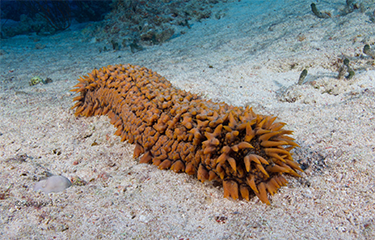Seychelles' sea cucumber populations declining

The number of sea cucumbers in Seychelles’ waters droppped 30 percent between 2004 and 2021 according to the findings of a new survey organized by the Seychelles Fishing Authority (SFA).
The survey, which was conducted by a team headed by Australian consultant Tim Skewes, working in conjunction with a group of local sea cucumber divers, had the objective of assessing and generating data on Seychelles’ cucumber resource – including that which is not currently commercially harvested.
Among the findings was that the black teatfish in the Seychelles is under serious threat, with the species’ population crashing from 7.5 million in 2004 to 1.4 million in 2021. Numbers of two other species, white teatfish and pentard, declined from 4.5 million for each species in 2004 to 500,000 and 2.4 million in 2021, respectively.
The one exception is the prickly redfish, whose numbers have increased from 3 million in 2004 to more than 4.5 million in 2021.
Although there could be many factors contributing to the decline in Seychelles sea cucumbers, Skewes attributed the trend to climate change, which he said “is affecting the ecosystem and fisheries.”
The survey aimed to review 206 sites in Mahe Plateau and Amirante islands – but due to visibility challenges and strong sea currents, data was only collected from 192 sites.
The survey's findings were presented in early September 2022 to a team working on a strategy to improve the nation’s sea cucumber industry's productivity.
The World Bank has reported the Seychelles’ sea cucumber catches have been on a steady decline since they peaked in 2012. That led to the country's government to introduce quotas as a requirement of its participation in the World Bank-financed South West Indian Ocean Fisheries Governance and Shared Growth Project (SWIOFish).
The quotas’ objective is “to arrest further declines and prevent the rapid collapse that is common to these fisheries globally.”
According to the World Bank, sea cucumber species, especially those that are the most-prized in Asia, include the flower teatfish, the white teatfish, and the prickly red teatfish, “are also overexploited and endangered.”
“Once the catches have peaked and are on a downward trajectory, it is unlikely that management interventions, other than complete closure of the fishery, can rebuild stocks, since reproduction is already greatly impaired,” it said in a report.
The Convention on International Trade in Endangered Species (CITES), has previously suggested listing of sea cucumbers under its Appendix II, a category allows species to be traded only under regulations that ensure the business involved in the trade are implementing sustainable practices that don’t affect the viability of the species.
The World Bank estimated the value of sea cucumber exports from the Seychelles in 2019, including products that were dried, smoked, salted or in brine, at USD 4.2 million (EUR 4.26 million).
Photo courtesy of the Convention on International Trade in Endangered Species






Share